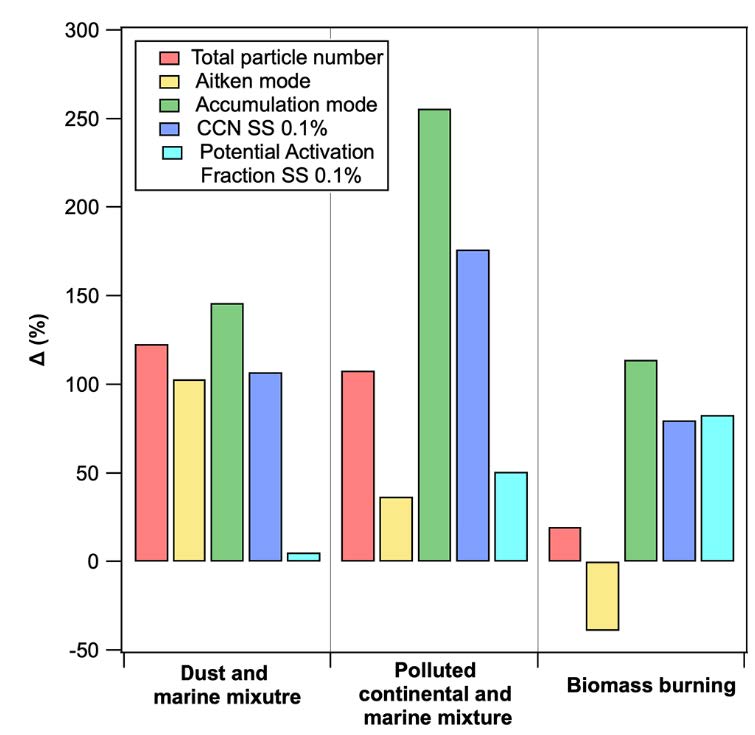Transported aerosol influences cloud condensation nuclei in the remote marine environment
Submitter
Aiken, Allison C
— Los Alamos National Laboratory
Area of Research
Aerosol Properties
Journal Reference
Gallo F, J Uin, K Sanchez, R Moore, J Wang, R Wood, F Mei, C Flynn, S Springston, E Azevedo, C Kuang, and A Aiken. 2023. "Long-range transported continental aerosol in the eastern North Atlantic: three multiday event regimes influence cloud condensation nuclei." Atmospheric Chemistry and Physics, 23(7), 10.5194/acp-23-4221-2023.
Science

Figure 1. Mean percentage change of aerosol number concentration and cloud condensation nuclei (CCN) activation fractions for the three types of long-range transport aerosol events observed at ENA by the ARM AOS in 2017. From journal.
Aerosols, also known as particles suspended in a gas, transported long distances in the atmosphere can have large impacts on cloud formation in remote marine environments. Over the course of a year, we identified three different sources of long-range transport particle events that increased cloud condensation nuclei (CCN; particles with the potential to form cloud droplets) concentrations in the Eastern North Atlantic (ENA) by 22%.
Impact
All three aerosol source types that were identified (dust/marine, polluted mix, biomass burning) significantly impacted the total number of submicron particles and CCN. The biomass-burning events had physicochemical properties that differed the most from the regional background aerosol, enhancing the particles’ ability to uptake water and activate into cloud droplets by a factor of two.
Summary
Remote marine environments are often characterized by low particle concentrations. For this reason, transported particle events can have large impacts on the clouds that form and their properties. We used data collected by the ARM Aerosol Observing System (AOS) at ENA to determine the annual variability of aerosol and to develop a new numerical algorithm by combining aerosol physical and optical properties to identify multiday long-range transport events. We categorized nine identified events in 2017 during the Aerosol and Cloud Experiments in the Eastern North Atlantic (ACE-ENA) campaign into three source types (dust/marine, polluted mix, biomass burning) using physicochemical properties and satellite classification retrievals. All three source types significantly impacted submicron particle and CCN concentrations. The biomass-burning particles exhibited the most different physicochemical properties. They increased the fraction of particles with the potential to form cloud droplets at supersaturations (SS) relevant for marine boundary-layer clouds by a factor of two over the background aerosol, up to 0.5 at SS of 0.1% and 0.8 at SS 0.2%. This translates to one out of two (SS 0.1%) or four out of five (SS 0.2%) of every particle in the plume had the potential to form a cloud droplet. Therefore, transported biomass-burning plumes are expected to have the largest impact on cloud properties and processes in this environment.
Keep up with the Atmospheric Observer
Updates on ARM news, events, and opportunities delivered to your inbox
ARM User Profile
ARM welcomes users from all institutions and nations. A free ARM user account is needed to access ARM data.


















